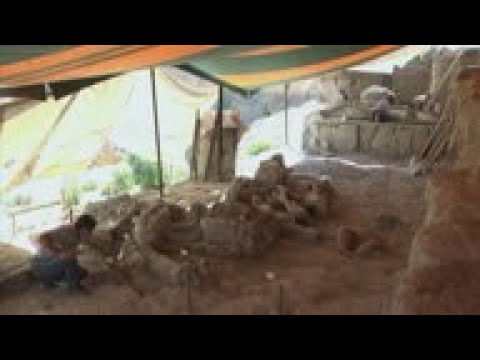Discovering the World’s First Mammoth Traps in Tultepec, Mexico
In the small town of Tultepec, just north of Mexico City, a discovery of monumental significance has captured the imaginations of archaeologists and history enthusiasts alike. Researchers have unearthed what are believed to be the world’s first mammoth traps, offering unprecedented insights into how the ancient peoples of the region may have hunted and interacted with these colossal creatures.
The traps, estimated to be an astonishing 15,000 years old, consist of large pits dug into the ground. Evidence suggests that these pits were strategically used to ensnare wandering mammoths, providing a communal source of food, tools, and possibly even clothing for the early inhabitants. The size and depth of these traps underscore the level of social organization and cooperation required to execute such an ingenious hunting strategy.
Excavations and analysis of the site have revealed more than just the physical dimensions of the traps. Bone fragments, tools, and various organic materials have been recovered, painting a vivid picture of prehistoric life. These artifacts allow researchers to piece together the day-to-day survival tactics of our ancient forebears and the immense challenges they faced.
Visitors and scholars flock to Tultepec in a bid to connect with this pivotal chapter in human history. The mammoth traps serve as a silent testament to the ingenuity and perseverance of early human societies, standing in stark contrast to the bustling modern-day Mexico that surrounds them. As ongoing excavations continue to uncover more about this site, Tultepec’s mammoth traps remain a humbling reminder of our shared past and the timeless allure of Mexico’s rich archaeological tapestry.
The Historical Significance of Mammoth Traps in Tultepec
In the heart of Mexico, a revolutionary discovery unveiled a remarkable chapter in prehistoric life. The mammoth traps found in Tultepec are not merely excavations but a window into the lives of the ancient peoples and the megafauna they encountered. Illuminating the survival tactics of early human hunters, these traps highlight an era where humankind stood toe-to-toe with the giants of the Ice Age.
The discovery of these traps in Tultepec has ignited a conversation about the sophistication of early human society in the region. It suggests that the inhabitants had developed advanced methods for hunting and likely possessed a deep understanding of the behaviors and patterns of the mammoths. Such strategic prowess is a testament to the intelligence and adaptability of these early peoples.
Surprisingly, the mammoth traps in Tultepec reveal that humans were capable of cooperative and large-scale planning. The management of such an ambitious hunt required a high level of communication and coordination among the group members. This discovery is reshaping our understanding of social responsibilities and communal life in prehistoric cultures.
The importance of these traps extends beyond historical interest; they hold significant value for the fields of archaeology and paleontology. The Tultepec site provides researchers with invaluable data on the types of tools used and the methods employed, inferring a more precise timeline for when humans began to exhibit complex hunting strategies.
Lastly, the mammoth traps are a humbling reminder of the transitory nature of existence itself. The remains found lay bare the reality of life and death in a world far removed from our own and yet intimately connected through the shared story of survival on our planet. As we continue to explore these remnants of the past, we gain not only knowledge but also a profound respect for the resilience of life through the ages.
Archaeological Wonders: Tultepec’s Ancient Mammoth Traps
The discovery of ancient mammoth traps in Tultepec has shed new light on the ingenuity of prehistoric human societies in Mexico. Found by accident during excavations for a landfill, this site has been named as one of the most significant finds in Mexican archaeology. The discovery presents evidence of a sophisticated understanding of mammoth behavior and strategic hunting techniques used by early inhabitants over 14,000 years ago.
Unlike other paleontological sites that suggest opportunistic scavenging, Tultepec’s pits suggest a level of organization and communal strategy. The excavation of these massive, man-made pits revealed the remains of more than a dozen mammoths, all showing signs of having been subjected to complex hunting tactics. These early humans carefully selected locations where mammoths commonly passed, dug deep pits, and possibly used torches and branches to drive these gargantuan beasts into the traps.
The importance of the Tultepec traps extends beyond their immediate archaeological value; they offer a glimpse into the social and cultural practices of the time. It is believed that the mammoth hunts likely involved the entire community and would have required planned cooperation, skillful execution, and possibly ritual significance. This site continues to captivate archaeologists and adventurers alike, promising further insights into the life of the earliest settlers in Mexico.
Exploring Prehistoric Mexico: The Mammoth Traps of Tultepec
Delve into the primordial landscapes of Tultepec, where history has been miraculously preserved through the discovery of ancient mammoth traps, offering a unique glimpse into prehistoric life. At this captivating site, estimated to be over 15,000 years old, visitors are transported back to a time when the municipality now known as Tultepec was once a fertile grassland teeming with megafauna such as mammoths, a prominent prey for the hunter-gatherer societies of the era.
The traps found in Tultepec are an extraordinary testament to the ingenuity of early humans inhabiting the region. These carefully engineered pits were designed to ensnare the gigantic Columbian mammoths that once roamed the valley. Excavations have unearthed more than a dozen pits containing mammoth remains, alongside evidence of human-crafted tools, hinting at the sophistication of these ancient hunters and the strategic tactics they employed to secure their massive catches.
Visitors captivated by the allure of prehistoric adventures can explore this archaeological wonder with guided tours that illuminate the significance of the findings. The mammoth traps of Tultepec not only provide insights into the subsistence strategies of pre-Columbian societies but also allow scientists to piece together the ecological conditions of Pleistocene Mexico. This unprecedented archaeological discovery challenges previous conceptions of human and mammoth interaction, showcasing a remarkable feat of early human civilization.
How the Tultepec Mammoth Traps Are Changing Our Understanding of History
The discovery of more than a dozen mammoth traps in Tultepec, Mexico, has been a groundbreaking event in the field of archaeology, providing new insights into the ingenuity of early humans in the region. These traps, believed to be around 15,000 years old, indicate that groups of early humans may have worked together in a complex social structure to hunt and capture these enormous creatures.
Prior research suggested that early humans were only scavengers, living off carcasses left behind by predators or natural causes. However, the Tultepec mammoth traps imply that these early inhabitants were sophisticated hunters. The size and scale of the traps, as well as the number of mammoth remains found within them, support the theory of active pursuit and capture, presenting a scenario where prehistoric communities planned and executed large-scale hunting strategies.
These findings are also reshaping our understanding of the impact humans had on megafauna at the time. The mass hunting implied by the mammoth traps suggests humans played a significant role in the extinction of the species. As archeologists continue to excavate and analyze the site, there may be deeper and far-reaching implications for the timeline of human-induced extinctions.
The study of tools, bones, and the sediment surrounding the Tultepec traps is providing new information about the environment and climate at the time of the mammoths. Carbon dating and other advanced techniques are helping scientists piece together a more accurate picture of life during the Pleistocene epoch, not only in Mexico but across the Americas. This knowledge is connecting dots between the movements, culture, and survival strategies of prehistoric peoples.
Unveiling the Secrets of Tultepec’s Mammoth Traps to the World
In the heart of Mexico, a remarkable window into the distant past has been uncovered, presenting an unprecedented glimpse into the lives of the mammoth hunters who once roamed the area. The discovery of mammoth traps in Tultepec, a town in the central state of Mexico, has astounded archaeologists and history enthusiasts alike. These pits, believed to be around 15,000 years old, were likely used by early humans to capture and kill these colossal creatures, providing a wealth of invaluable information about their hunting techniques and survival strategies.
The mammoth traps in Tultepec are not only the first of their kind to be discovered in Mexico, but they also challenge previous beliefs about how early humans interacted with these giant mammals. Excavations have revealed that the traps were strategically engineered deep pits, with evidence showing that groups of hunters would skillfully drive the mammoths into them. The size and design of the pits reflect an advanced level of cooperation and planning among prehistoric humans, which represents a significant understanding of human prehistory in this region.
Investigations and studies continue to decipher more clues hidden within these pits, detailing the way of life and the environment of an era long vanished. Experts are piecing together the techniques used by the hunters, including how they may have used natural vegetation and camouflaging methods to ensnare the mammoths. The insight gained from Tultepec’s mammoth traps not only enriches our knowledge of early human history in the Americas but also raises curiosity and invites further exploration into the ingenuity and adaptability of our ancestors.



